Analysis of SSL's Information Security Strategy
VerifiedAdded on 2023/04/04
|8
|2269
|404
AI Summary
This report analyzes the Information Security strategy of Security Services Limited (SSL) and suggests improvements for a more secure and scalable system. It discusses the different divisions of SSL, their independent systems, and the need for an updated IT infrastructure. The report also outlines a strategic plan for upgrading hardware, software, networking, and data systems to enhance operational efficiency and improve customer service.
Contribute Materials
Your contribution can guide someone’s learning journey. Share your
documents today.

Introduction 1
Portfolio Analysis assessment 1
IS Strategy 2
Strategic Potential 4
Location selection 5
Conclusion 6
Portfolio Analysis assessment 1
IS Strategy 2
Strategic Potential 4
Location selection 5
Conclusion 6
Secure Best Marks with AI Grader
Need help grading? Try our AI Grader for instant feedback on your assignments.
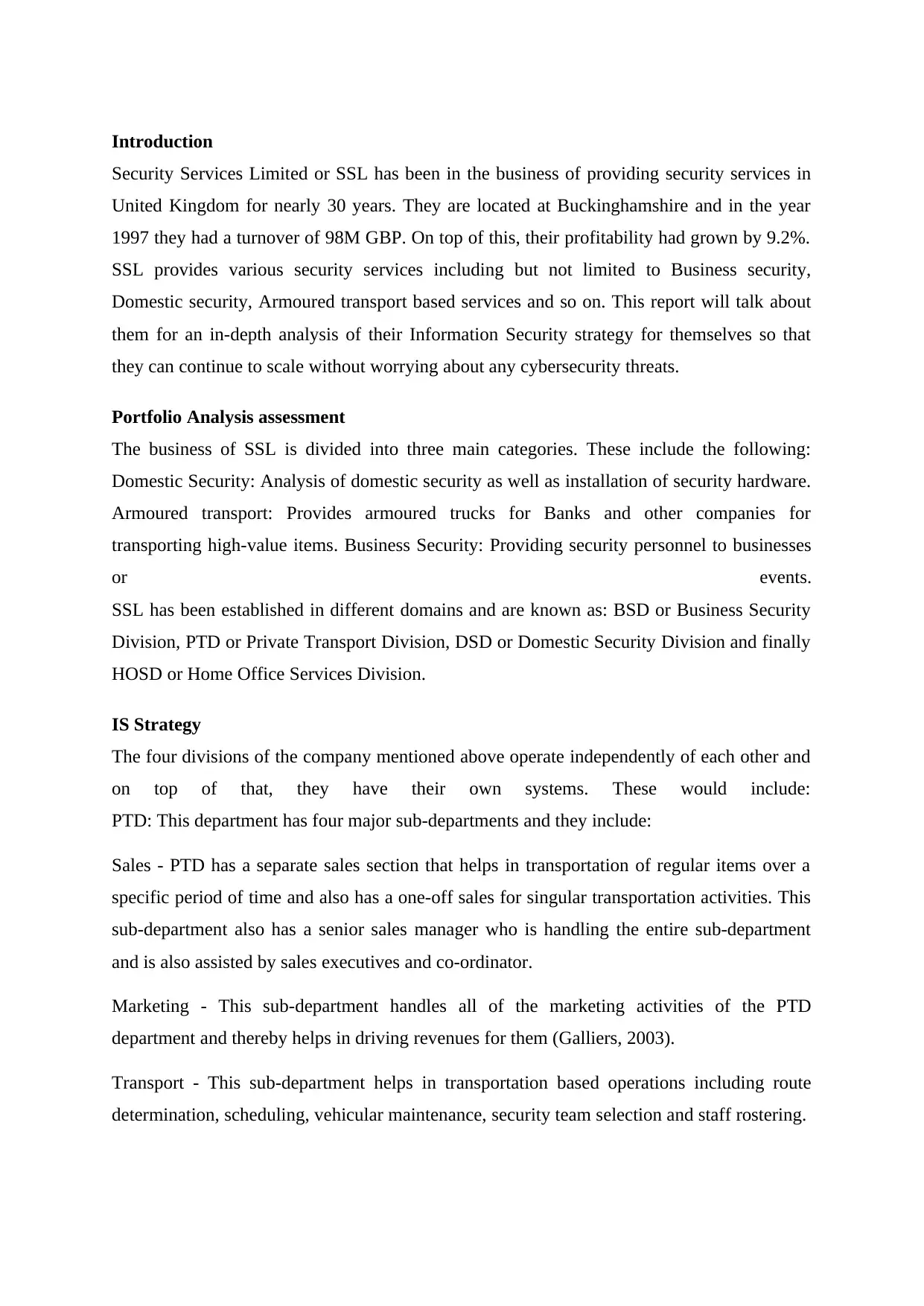
Introduction
Security Services Limited or SSL has been in the business of providing security services in
United Kingdom for nearly 30 years. They are located at Buckinghamshire and in the year
1997 they had a turnover of 98M GBP. On top of this, their profitability had grown by 9.2%.
SSL provides various security services including but not limited to Business security,
Domestic security, Armoured transport based services and so on. This report will talk about
them for an in-depth analysis of their Information Security strategy for themselves so that
they can continue to scale without worrying about any cybersecurity threats.
Portfolio Analysis assessment
The business of SSL is divided into three main categories. These include the following:
Domestic Security: Analysis of domestic security as well as installation of security hardware.
Armoured transport: Provides armoured trucks for Banks and other companies for
transporting high-value items. Business Security: Providing security personnel to businesses
or events.
SSL has been established in different domains and are known as: BSD or Business Security
Division, PTD or Private Transport Division, DSD or Domestic Security Division and finally
HOSD or Home Office Services Division.
IS Strategy
The four divisions of the company mentioned above operate independently of each other and
on top of that, they have their own systems. These would include:
PTD: This department has four major sub-departments and they include:
Sales - PTD has a separate sales section that helps in transportation of regular items over a
specific period of time and also has a one-off sales for singular transportation activities. This
sub-department also has a senior sales manager who is handling the entire sub-department
and is also assisted by sales executives and co-ordinator.
Marketing - This sub-department handles all of the marketing activities of the PTD
department and thereby helps in driving revenues for them (Galliers, 2003).
Transport - This sub-department helps in transportation based operations including route
determination, scheduling, vehicular maintenance, security team selection and staff rostering.
Security Services Limited or SSL has been in the business of providing security services in
United Kingdom for nearly 30 years. They are located at Buckinghamshire and in the year
1997 they had a turnover of 98M GBP. On top of this, their profitability had grown by 9.2%.
SSL provides various security services including but not limited to Business security,
Domestic security, Armoured transport based services and so on. This report will talk about
them for an in-depth analysis of their Information Security strategy for themselves so that
they can continue to scale without worrying about any cybersecurity threats.
Portfolio Analysis assessment
The business of SSL is divided into three main categories. These include the following:
Domestic Security: Analysis of domestic security as well as installation of security hardware.
Armoured transport: Provides armoured trucks for Banks and other companies for
transporting high-value items. Business Security: Providing security personnel to businesses
or events.
SSL has been established in different domains and are known as: BSD or Business Security
Division, PTD or Private Transport Division, DSD or Domestic Security Division and finally
HOSD or Home Office Services Division.
IS Strategy
The four divisions of the company mentioned above operate independently of each other and
on top of that, they have their own systems. These would include:
PTD: This department has four major sub-departments and they include:
Sales - PTD has a separate sales section that helps in transportation of regular items over a
specific period of time and also has a one-off sales for singular transportation activities. This
sub-department also has a senior sales manager who is handling the entire sub-department
and is also assisted by sales executives and co-ordinator.
Marketing - This sub-department handles all of the marketing activities of the PTD
department and thereby helps in driving revenues for them (Galliers, 2003).
Transport - This sub-department helps in transportation based operations including route
determination, scheduling, vehicular maintenance, security team selection and staff rostering.
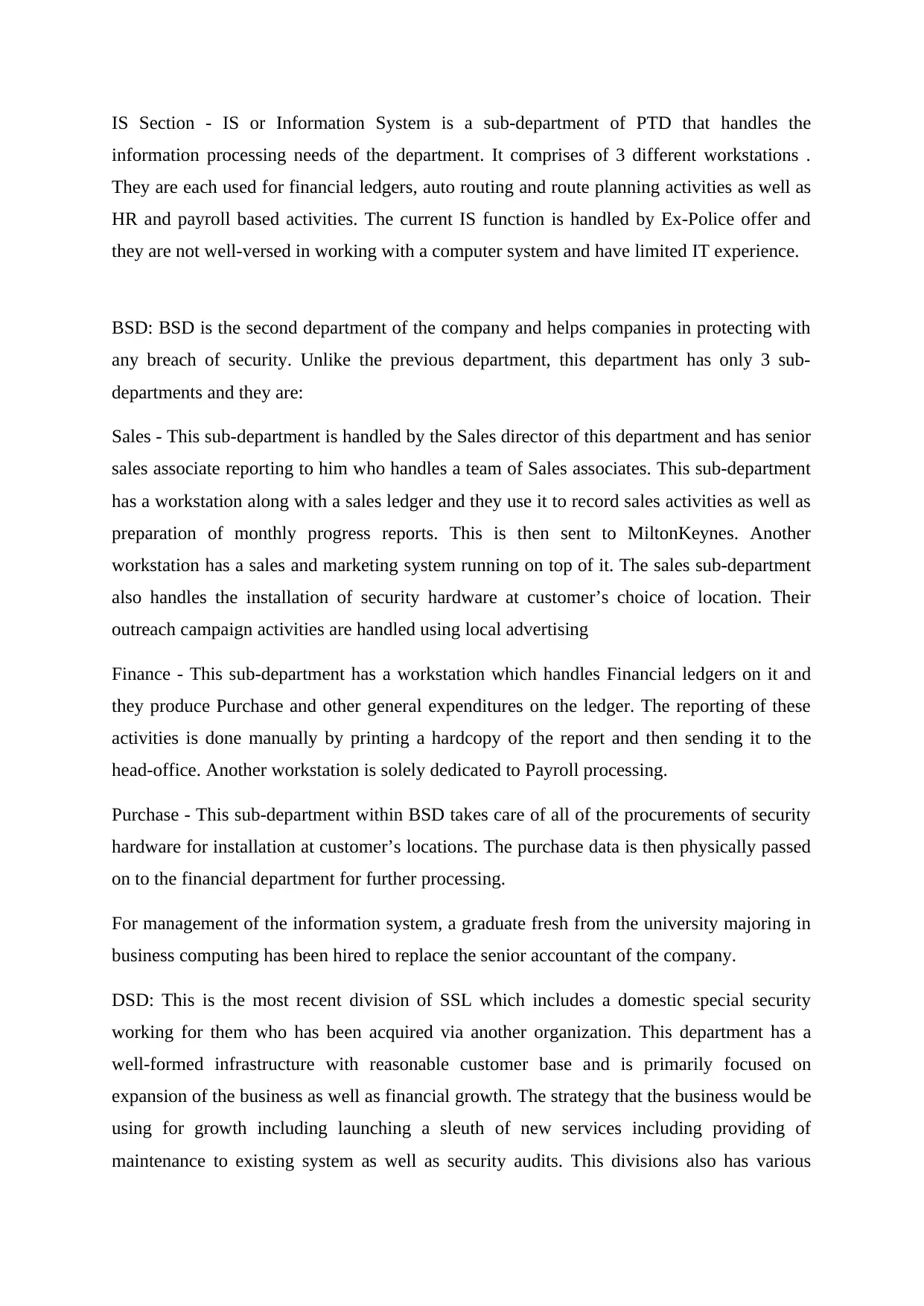
IS Section - IS or Information System is a sub-department of PTD that handles the
information processing needs of the department. It comprises of 3 different workstations .
They are each used for financial ledgers, auto routing and route planning activities as well as
HR and payroll based activities. The current IS function is handled by Ex-Police offer and
they are not well-versed in working with a computer system and have limited IT experience.
BSD: BSD is the second department of the company and helps companies in protecting with
any breach of security. Unlike the previous department, this department has only 3 sub-
departments and they are:
Sales - This sub-department is handled by the Sales director of this department and has senior
sales associate reporting to him who handles a team of Sales associates. This sub-department
has a workstation along with a sales ledger and they use it to record sales activities as well as
preparation of monthly progress reports. This is then sent to MiltonKeynes. Another
workstation has a sales and marketing system running on top of it. The sales sub-department
also handles the installation of security hardware at customer’s choice of location. Their
outreach campaign activities are handled using local advertising
Finance - This sub-department has a workstation which handles Financial ledgers on it and
they produce Purchase and other general expenditures on the ledger. The reporting of these
activities is done manually by printing a hardcopy of the report and then sending it to the
head-office. Another workstation is solely dedicated to Payroll processing.
Purchase - This sub-department within BSD takes care of all of the procurements of security
hardware for installation at customer’s locations. The purchase data is then physically passed
on to the financial department for further processing.
For management of the information system, a graduate fresh from the university majoring in
business computing has been hired to replace the senior accountant of the company.
DSD: This is the most recent division of SSL which includes a domestic special security
working for them who has been acquired via another organization. This department has a
well-formed infrastructure with reasonable customer base and is primarily focused on
expansion of the business as well as financial growth. The strategy that the business would be
using for growth including launching a sleuth of new services including providing of
maintenance to existing system as well as security audits. This divisions also has various
information processing needs of the department. It comprises of 3 different workstations .
They are each used for financial ledgers, auto routing and route planning activities as well as
HR and payroll based activities. The current IS function is handled by Ex-Police offer and
they are not well-versed in working with a computer system and have limited IT experience.
BSD: BSD is the second department of the company and helps companies in protecting with
any breach of security. Unlike the previous department, this department has only 3 sub-
departments and they are:
Sales - This sub-department is handled by the Sales director of this department and has senior
sales associate reporting to him who handles a team of Sales associates. This sub-department
has a workstation along with a sales ledger and they use it to record sales activities as well as
preparation of monthly progress reports. This is then sent to MiltonKeynes. Another
workstation has a sales and marketing system running on top of it. The sales sub-department
also handles the installation of security hardware at customer’s choice of location. Their
outreach campaign activities are handled using local advertising
Finance - This sub-department has a workstation which handles Financial ledgers on it and
they produce Purchase and other general expenditures on the ledger. The reporting of these
activities is done manually by printing a hardcopy of the report and then sending it to the
head-office. Another workstation is solely dedicated to Payroll processing.
Purchase - This sub-department within BSD takes care of all of the procurements of security
hardware for installation at customer’s locations. The purchase data is then physically passed
on to the financial department for further processing.
For management of the information system, a graduate fresh from the university majoring in
business computing has been hired to replace the senior accountant of the company.
DSD: This is the most recent division of SSL which includes a domestic special security
working for them who has been acquired via another organization. This department has a
well-formed infrastructure with reasonable customer base and is primarily focused on
expansion of the business as well as financial growth. The strategy that the business would be
using for growth including launching a sleuth of new services including providing of
maintenance to existing system as well as security audits. This divisions also has various
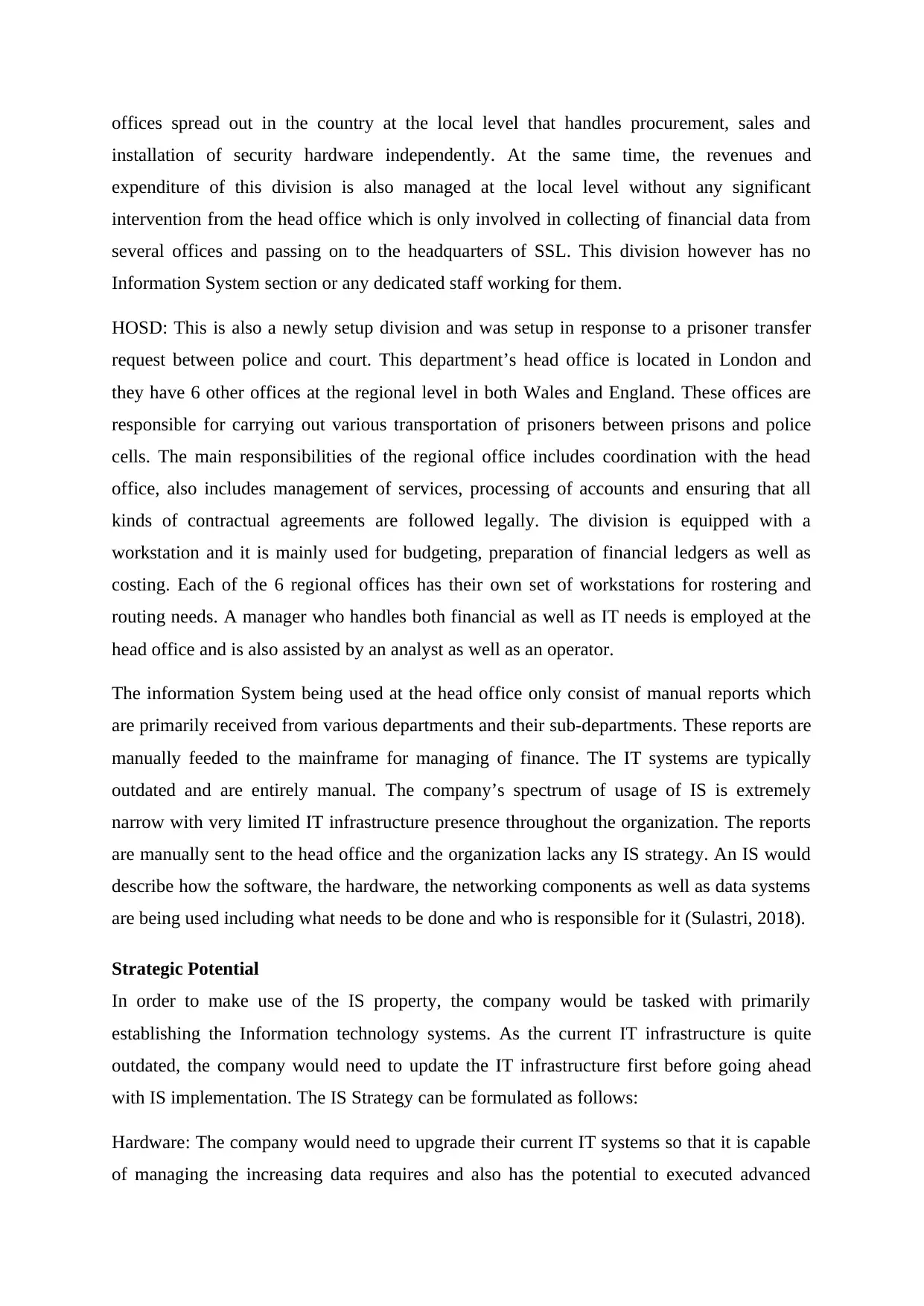
offices spread out in the country at the local level that handles procurement, sales and
installation of security hardware independently. At the same time, the revenues and
expenditure of this division is also managed at the local level without any significant
intervention from the head office which is only involved in collecting of financial data from
several offices and passing on to the headquarters of SSL. This division however has no
Information System section or any dedicated staff working for them.
HOSD: This is also a newly setup division and was setup in response to a prisoner transfer
request between police and court. This department’s head office is located in London and
they have 6 other offices at the regional level in both Wales and England. These offices are
responsible for carrying out various transportation of prisoners between prisons and police
cells. The main responsibilities of the regional office includes coordination with the head
office, also includes management of services, processing of accounts and ensuring that all
kinds of contractual agreements are followed legally. The division is equipped with a
workstation and it is mainly used for budgeting, preparation of financial ledgers as well as
costing. Each of the 6 regional offices has their own set of workstations for rostering and
routing needs. A manager who handles both financial as well as IT needs is employed at the
head office and is also assisted by an analyst as well as an operator.
The information System being used at the head office only consist of manual reports which
are primarily received from various departments and their sub-departments. These reports are
manually feeded to the mainframe for managing of finance. The IT systems are typically
outdated and are entirely manual. The company’s spectrum of usage of IS is extremely
narrow with very limited IT infrastructure presence throughout the organization. The reports
are manually sent to the head office and the organization lacks any IS strategy. An IS would
describe how the software, the hardware, the networking components as well as data systems
are being used including what needs to be done and who is responsible for it (Sulastri, 2018).
Strategic Potential
In order to make use of the IS property, the company would be tasked with primarily
establishing the Information technology systems. As the current IT infrastructure is quite
outdated, the company would need to update the IT infrastructure first before going ahead
with IS implementation. The IS Strategy can be formulated as follows:
Hardware: The company would need to upgrade their current IT systems so that it is capable
of managing the increasing data requires and also has the potential to executed advanced
installation of security hardware independently. At the same time, the revenues and
expenditure of this division is also managed at the local level without any significant
intervention from the head office which is only involved in collecting of financial data from
several offices and passing on to the headquarters of SSL. This division however has no
Information System section or any dedicated staff working for them.
HOSD: This is also a newly setup division and was setup in response to a prisoner transfer
request between police and court. This department’s head office is located in London and
they have 6 other offices at the regional level in both Wales and England. These offices are
responsible for carrying out various transportation of prisoners between prisons and police
cells. The main responsibilities of the regional office includes coordination with the head
office, also includes management of services, processing of accounts and ensuring that all
kinds of contractual agreements are followed legally. The division is equipped with a
workstation and it is mainly used for budgeting, preparation of financial ledgers as well as
costing. Each of the 6 regional offices has their own set of workstations for rostering and
routing needs. A manager who handles both financial as well as IT needs is employed at the
head office and is also assisted by an analyst as well as an operator.
The information System being used at the head office only consist of manual reports which
are primarily received from various departments and their sub-departments. These reports are
manually feeded to the mainframe for managing of finance. The IT systems are typically
outdated and are entirely manual. The company’s spectrum of usage of IS is extremely
narrow with very limited IT infrastructure presence throughout the organization. The reports
are manually sent to the head office and the organization lacks any IS strategy. An IS would
describe how the software, the hardware, the networking components as well as data systems
are being used including what needs to be done and who is responsible for it (Sulastri, 2018).
Strategic Potential
In order to make use of the IS property, the company would be tasked with primarily
establishing the Information technology systems. As the current IT infrastructure is quite
outdated, the company would need to update the IT infrastructure first before going ahead
with IS implementation. The IS Strategy can be formulated as follows:
Hardware: The company would need to upgrade their current IT systems so that it is capable
of managing the increasing data requires and also has the potential to executed advanced
Secure Best Marks with AI Grader
Need help grading? Try our AI Grader for instant feedback on your assignments.
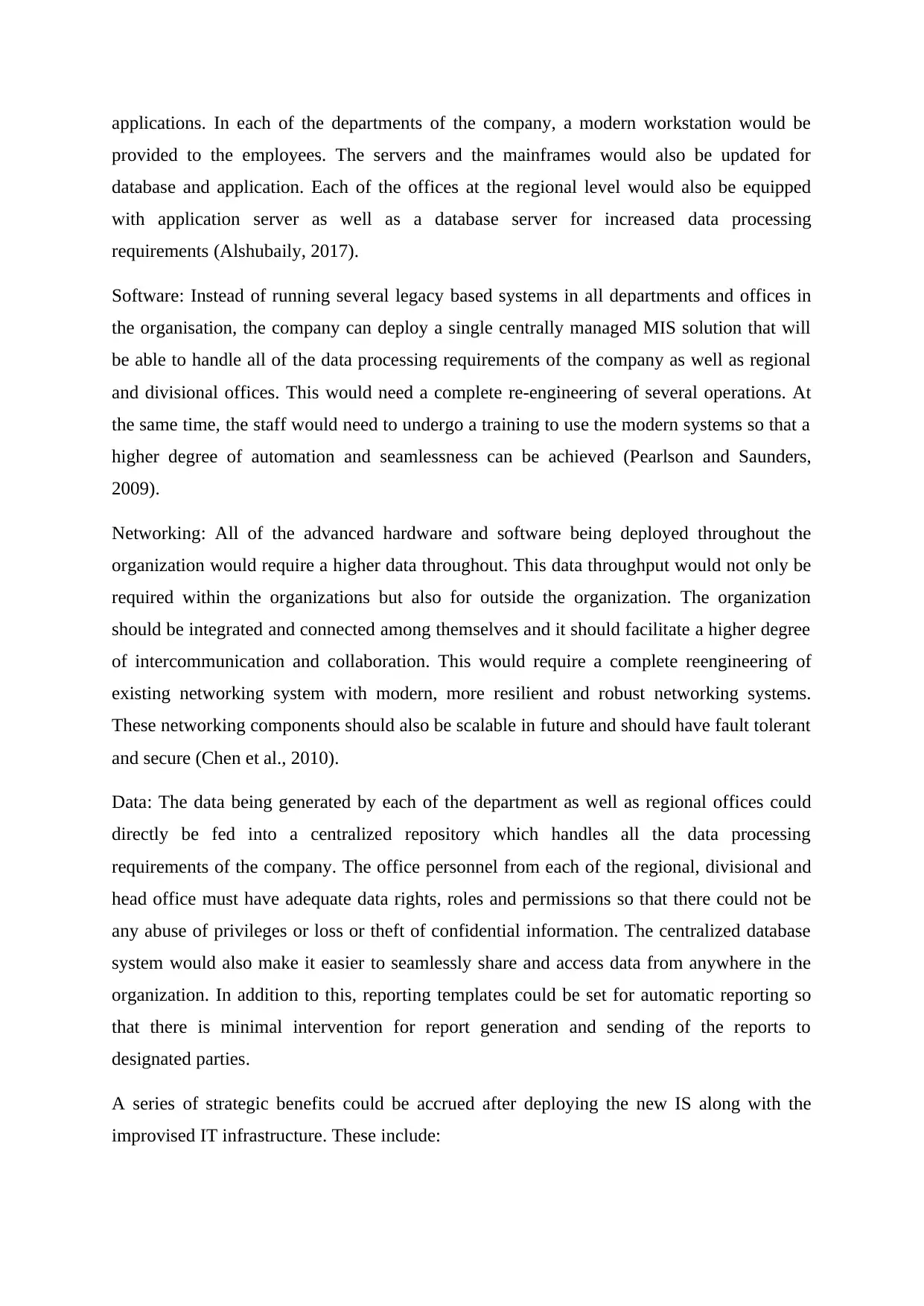
applications. In each of the departments of the company, a modern workstation would be
provided to the employees. The servers and the mainframes would also be updated for
database and application. Each of the offices at the regional level would also be equipped
with application server as well as a database server for increased data processing
requirements (Alshubaily, 2017).
Software: Instead of running several legacy based systems in all departments and offices in
the organisation, the company can deploy a single centrally managed MIS solution that will
be able to handle all of the data processing requirements of the company as well as regional
and divisional offices. This would need a complete re-engineering of several operations. At
the same time, the staff would need to undergo a training to use the modern systems so that a
higher degree of automation and seamlessness can be achieved (Pearlson and Saunders,
2009).
Networking: All of the advanced hardware and software being deployed throughout the
organization would require a higher data throughout. This data throughput would not only be
required within the organizations but also for outside the organization. The organization
should be integrated and connected among themselves and it should facilitate a higher degree
of intercommunication and collaboration. This would require a complete reengineering of
existing networking system with modern, more resilient and robust networking systems.
These networking components should also be scalable in future and should have fault tolerant
and secure (Chen et al., 2010).
Data: The data being generated by each of the department as well as regional offices could
directly be fed into a centralized repository which handles all the data processing
requirements of the company. The office personnel from each of the regional, divisional and
head office must have adequate data rights, roles and permissions so that there could not be
any abuse of privileges or loss or theft of confidential information. The centralized database
system would also make it easier to seamlessly share and access data from anywhere in the
organization. In addition to this, reporting templates could be set for automatic reporting so
that there is minimal intervention for report generation and sending of the reports to
designated parties.
A series of strategic benefits could be accrued after deploying the new IS along with the
improvised IT infrastructure. These include:
provided to the employees. The servers and the mainframes would also be updated for
database and application. Each of the offices at the regional level would also be equipped
with application server as well as a database server for increased data processing
requirements (Alshubaily, 2017).
Software: Instead of running several legacy based systems in all departments and offices in
the organisation, the company can deploy a single centrally managed MIS solution that will
be able to handle all of the data processing requirements of the company as well as regional
and divisional offices. This would need a complete re-engineering of several operations. At
the same time, the staff would need to undergo a training to use the modern systems so that a
higher degree of automation and seamlessness can be achieved (Pearlson and Saunders,
2009).
Networking: All of the advanced hardware and software being deployed throughout the
organization would require a higher data throughout. This data throughput would not only be
required within the organizations but also for outside the organization. The organization
should be integrated and connected among themselves and it should facilitate a higher degree
of intercommunication and collaboration. This would require a complete reengineering of
existing networking system with modern, more resilient and robust networking systems.
These networking components should also be scalable in future and should have fault tolerant
and secure (Chen et al., 2010).
Data: The data being generated by each of the department as well as regional offices could
directly be fed into a centralized repository which handles all the data processing
requirements of the company. The office personnel from each of the regional, divisional and
head office must have adequate data rights, roles and permissions so that there could not be
any abuse of privileges or loss or theft of confidential information. The centralized database
system would also make it easier to seamlessly share and access data from anywhere in the
organization. In addition to this, reporting templates could be set for automatic reporting so
that there is minimal intervention for report generation and sending of the reports to
designated parties.
A series of strategic benefits could be accrued after deploying the new IS along with the
improvised IT infrastructure. These include:
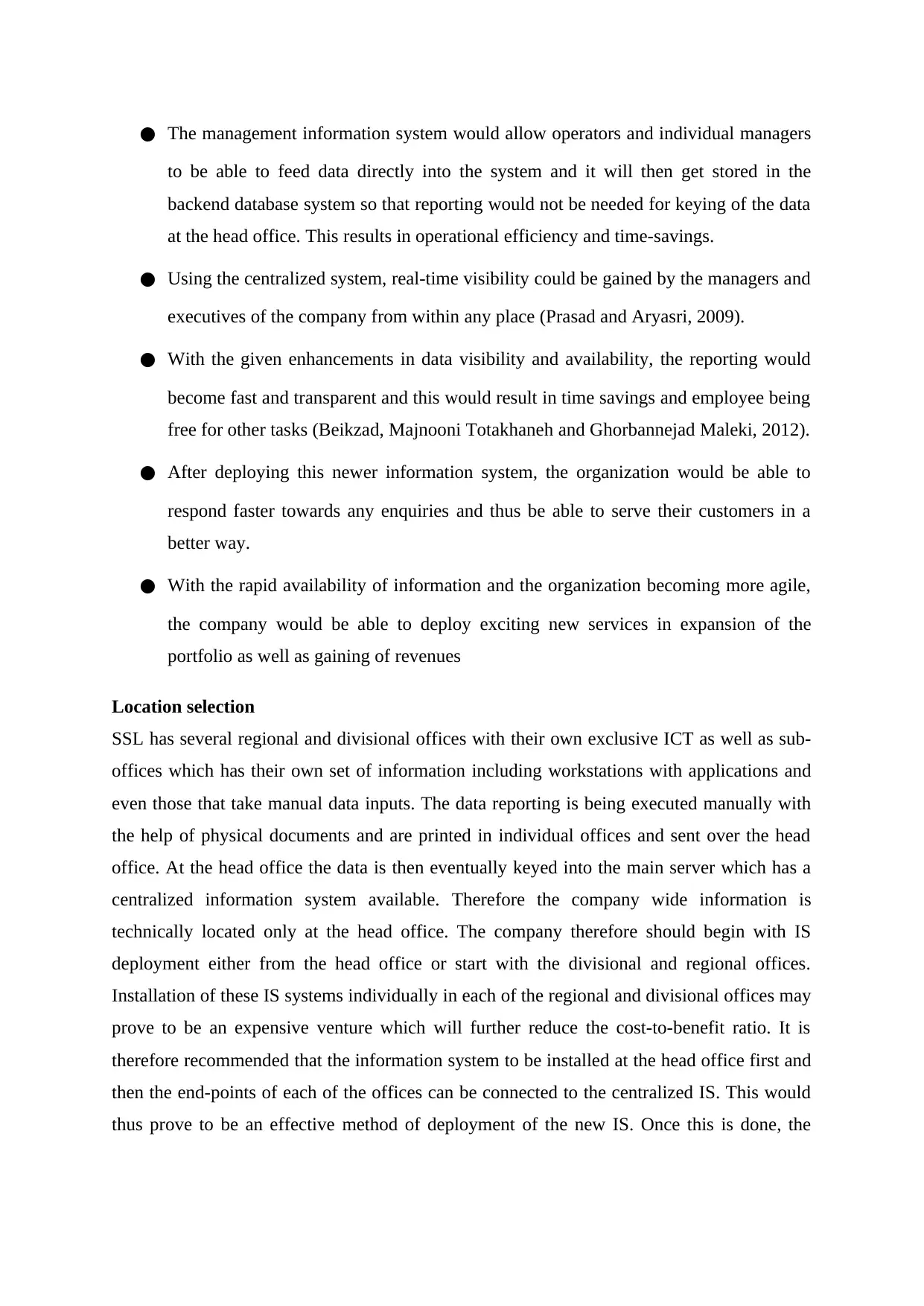
● The management information system would allow operators and individual managers
to be able to feed data directly into the system and it will then get stored in the
backend database system so that reporting would not be needed for keying of the data
at the head office. This results in operational efficiency and time-savings.
● Using the centralized system, real-time visibility could be gained by the managers and
executives of the company from within any place (Prasad and Aryasri, 2009).
● With the given enhancements in data visibility and availability, the reporting would
become fast and transparent and this would result in time savings and employee being
free for other tasks (Beikzad, Majnooni Totakhaneh and Ghorbannejad Maleki, 2012).
● After deploying this newer information system, the organization would be able to
respond faster towards any enquiries and thus be able to serve their customers in a
better way.
● With the rapid availability of information and the organization becoming more agile,
the company would be able to deploy exciting new services in expansion of the
portfolio as well as gaining of revenues
Location selection
SSL has several regional and divisional offices with their own exclusive ICT as well as sub-
offices which has their own set of information including workstations with applications and
even those that take manual data inputs. The data reporting is being executed manually with
the help of physical documents and are printed in individual offices and sent over the head
office. At the head office the data is then eventually keyed into the main server which has a
centralized information system available. Therefore the company wide information is
technically located only at the head office. The company therefore should begin with IS
deployment either from the head office or start with the divisional and regional offices.
Installation of these IS systems individually in each of the regional and divisional offices may
prove to be an expensive venture which will further reduce the cost-to-benefit ratio. It is
therefore recommended that the information system to be installed at the head office first and
then the end-points of each of the offices can be connected to the centralized IS. This would
thus prove to be an effective method of deployment of the new IS. Once this is done, the
to be able to feed data directly into the system and it will then get stored in the
backend database system so that reporting would not be needed for keying of the data
at the head office. This results in operational efficiency and time-savings.
● Using the centralized system, real-time visibility could be gained by the managers and
executives of the company from within any place (Prasad and Aryasri, 2009).
● With the given enhancements in data visibility and availability, the reporting would
become fast and transparent and this would result in time savings and employee being
free for other tasks (Beikzad, Majnooni Totakhaneh and Ghorbannejad Maleki, 2012).
● After deploying this newer information system, the organization would be able to
respond faster towards any enquiries and thus be able to serve their customers in a
better way.
● With the rapid availability of information and the organization becoming more agile,
the company would be able to deploy exciting new services in expansion of the
portfolio as well as gaining of revenues
Location selection
SSL has several regional and divisional offices with their own exclusive ICT as well as sub-
offices which has their own set of information including workstations with applications and
even those that take manual data inputs. The data reporting is being executed manually with
the help of physical documents and are printed in individual offices and sent over the head
office. At the head office the data is then eventually keyed into the main server which has a
centralized information system available. Therefore the company wide information is
technically located only at the head office. The company therefore should begin with IS
deployment either from the head office or start with the divisional and regional offices.
Installation of these IS systems individually in each of the regional and divisional offices may
prove to be an expensive venture which will further reduce the cost-to-benefit ratio. It is
therefore recommended that the information system to be installed at the head office first and
then the end-points of each of the offices can be connected to the centralized IS. This would
thus prove to be an effective method of deployment of the new IS. Once this is done, the
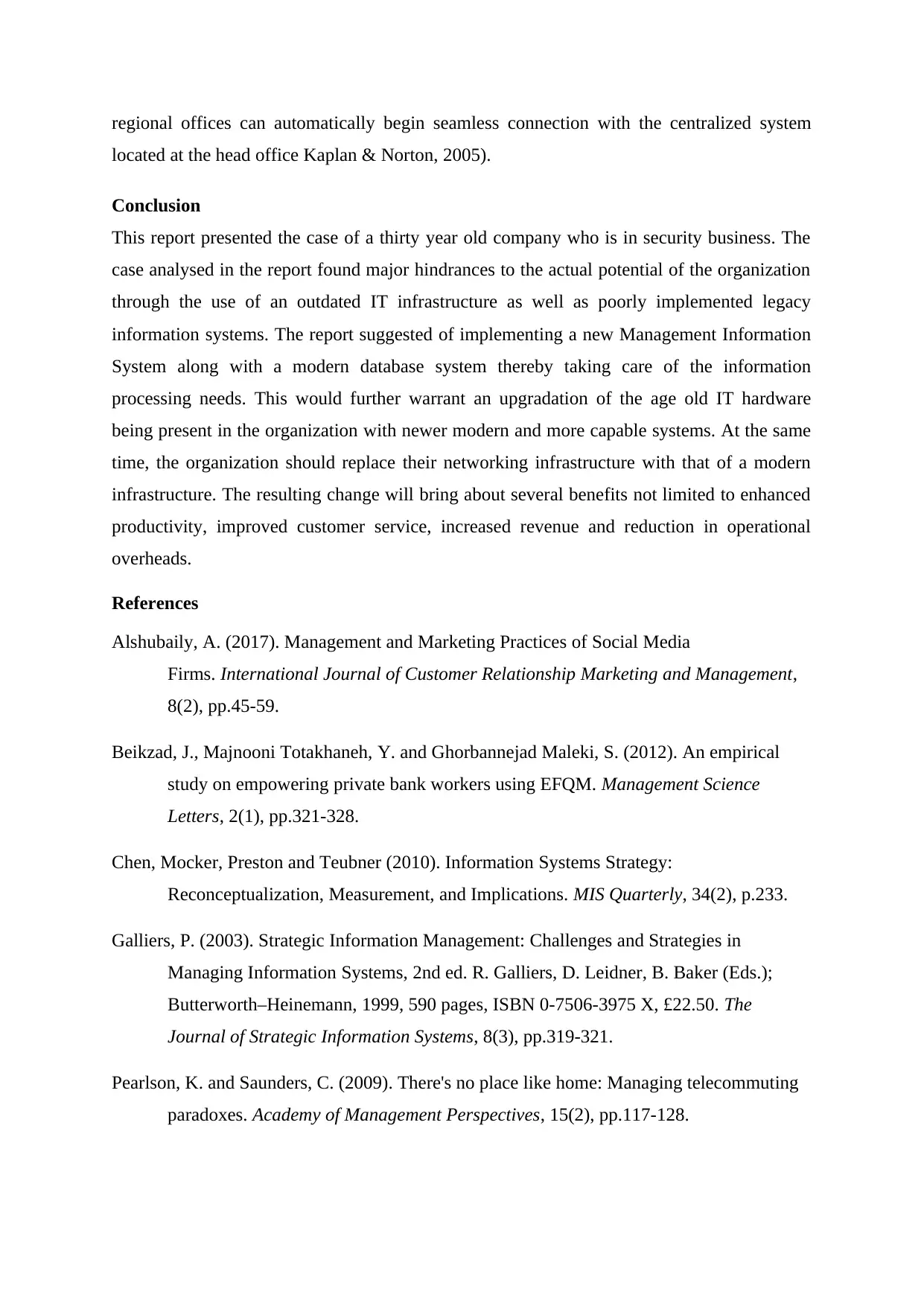
regional offices can automatically begin seamless connection with the centralized system
located at the head office Kaplan & Norton, 2005).
Conclusion
This report presented the case of a thirty year old company who is in security business. The
case analysed in the report found major hindrances to the actual potential of the organization
through the use of an outdated IT infrastructure as well as poorly implemented legacy
information systems. The report suggested of implementing a new Management Information
System along with a modern database system thereby taking care of the information
processing needs. This would further warrant an upgradation of the age old IT hardware
being present in the organization with newer modern and more capable systems. At the same
time, the organization should replace their networking infrastructure with that of a modern
infrastructure. The resulting change will bring about several benefits not limited to enhanced
productivity, improved customer service, increased revenue and reduction in operational
overheads.
References
Alshubaily, A. (2017). Management and Marketing Practices of Social Media
Firms. International Journal of Customer Relationship Marketing and Management,
8(2), pp.45-59.
Beikzad, J., Majnooni Totakhaneh, Y. and Ghorbannejad Maleki, S. (2012). An empirical
study on empowering private bank workers using EFQM. Management Science
Letters, 2(1), pp.321-328.
Chen, Mocker, Preston and Teubner (2010). Information Systems Strategy:
Reconceptualization, Measurement, and Implications. MIS Quarterly, 34(2), p.233.
Galliers, P. (2003). Strategic Information Management: Challenges and Strategies in
Managing Information Systems, 2nd ed. R. Galliers, D. Leidner, B. Baker (Eds.);
Butterworth–Heinemann, 1999, 590 pages, ISBN 0-7506-3975 X, £22.50. The
Journal of Strategic Information Systems, 8(3), pp.319-321.
Pearlson, K. and Saunders, C. (2009). There's no place like home: Managing telecommuting
paradoxes. Academy of Management Perspectives, 15(2), pp.117-128.
located at the head office Kaplan & Norton, 2005).
Conclusion
This report presented the case of a thirty year old company who is in security business. The
case analysed in the report found major hindrances to the actual potential of the organization
through the use of an outdated IT infrastructure as well as poorly implemented legacy
information systems. The report suggested of implementing a new Management Information
System along with a modern database system thereby taking care of the information
processing needs. This would further warrant an upgradation of the age old IT hardware
being present in the organization with newer modern and more capable systems. At the same
time, the organization should replace their networking infrastructure with that of a modern
infrastructure. The resulting change will bring about several benefits not limited to enhanced
productivity, improved customer service, increased revenue and reduction in operational
overheads.
References
Alshubaily, A. (2017). Management and Marketing Practices of Social Media
Firms. International Journal of Customer Relationship Marketing and Management,
8(2), pp.45-59.
Beikzad, J., Majnooni Totakhaneh, Y. and Ghorbannejad Maleki, S. (2012). An empirical
study on empowering private bank workers using EFQM. Management Science
Letters, 2(1), pp.321-328.
Chen, Mocker, Preston and Teubner (2010). Information Systems Strategy:
Reconceptualization, Measurement, and Implications. MIS Quarterly, 34(2), p.233.
Galliers, P. (2003). Strategic Information Management: Challenges and Strategies in
Managing Information Systems, 2nd ed. R. Galliers, D. Leidner, B. Baker (Eds.);
Butterworth–Heinemann, 1999, 590 pages, ISBN 0-7506-3975 X, £22.50. The
Journal of Strategic Information Systems, 8(3), pp.319-321.
Pearlson, K. and Saunders, C. (2009). There's no place like home: Managing telecommuting
paradoxes. Academy of Management Perspectives, 15(2), pp.117-128.
Paraphrase This Document
Need a fresh take? Get an instant paraphrase of this document with our AI Paraphraser

Prasad, C. and Aryasri, A. (2009). Determinants of Shopper Behaviour in E-tailing: An
Empirical Analysis. Paradigm, 13(1), pp.73-83.
Sulastri, H. (2018). IT Strategy Of Human Resource Information System (HRIS) to Achieve
Green It Strategy. Jurnal Rekayasa Sistem & Industri (JRSI), 4(02).
Empirical Analysis. Paradigm, 13(1), pp.73-83.
Sulastri, H. (2018). IT Strategy Of Human Resource Information System (HRIS) to Achieve
Green It Strategy. Jurnal Rekayasa Sistem & Industri (JRSI), 4(02).
1 out of 8
Related Documents
Your All-in-One AI-Powered Toolkit for Academic Success.
+13062052269
info@desklib.com
Available 24*7 on WhatsApp / Email
![[object Object]](/_next/static/media/star-bottom.7253800d.svg)
Unlock your academic potential
© 2024 | Zucol Services PVT LTD | All rights reserved.




